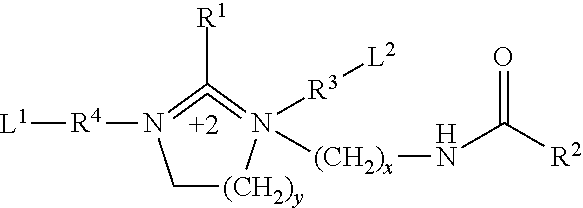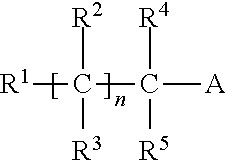Liquid Inhibitor Composition And A Method For Its Preparation And Application As A Heavy Brine Corrosion Control
a technology of heavy brine and composition, applied in the field of corrosion inhibitors, can solve the problems of heavy brine corrosivity, environmental hazards, complex brines are generally corrosive and costly,
- Summary
- Abstract
- Description
- Claims
- Application Information
AI Technical Summary
Benefits of technology
Problems solved by technology
Method used
Image
Examples
example 1
Examples
[0156]Uninhibited tests were performed first of all in order to understand the baseline corrosion rate; the following readings, displayed in Table 1, were obtained in the static HPHT autoclave tests at 300 and 350° F.:
TABLE 1Uninhibited corrosion rate results on heavy brinesHeavy Brine300° F. (mpy)350° F. (mpy)No.Brine 1 - 10.8 PPG Ca(NO3)28.414.81.1Brine 2 - 12.5 PPG Ca(NO3)211.520.61.2Brine 3 - 11.6 PPG CaCl212.626.81.3Brine 4 - 13.5 Ca(NO3)2 / CaCl225.448.21.4
[0157]Individual components were then tested to determine further baseline effects. Components were selected from groups 1, 2, 3, and 4 above; namely 1:1 tallow / DETA imidazoline (component Group 1), thioglycolic acid (component Group 2), poly(oxy-1,2-ethanediyl), alpha-isotridecyl-omega-hydroxy-, phosphate (component Group 3), and alkyl (C6) morpholine (component Group 4).
[0158]The results of the harshest brine 4 (13.5 Ca(NO3)2 / CaCl2) at 350° F. are shown below in Table 2. It can be seen that only small decreases in co...
example 2
ponent System
[0159]Work continued on three component systems with the aim of identifying the most synergistic relationship between the components. Again work was performed on the harshest brine 4 (13.5 Ca(NO3)2 / CaCl2) at 350° F. are shown below in Table 3. Based on these results one can surprisingly see the phosphate ester component leads to high corrosion inhibitor performance, the phosphate ester itself is not a great corrosion inhibitor and it is surprisingly synergistic with the other components within the three component blend. This is not however a linear relationship and various synergistic and antagonistic relationships can be discerned in the data;[0160]1. When a phosphate ester was absent the corrosion rates were in general much higher;[0161]2. When an imidazoline was absent the corrosion rates were high;[0162]3. The uniqueness and high performance of corrosion inhibiting composition is related to the understanding of the relationships between components and identifying th...
example 3
osphate Ester in a Four Component System
[0163]The use of phosphate ester in Example 2 led to high corrosion inhibition performance in the three component system. More specific work was performed on phosphate ester chemistries in order to fully understand and leverage this performance. Testing was performed on a great many different phosphate ester chemistries in order to identify the most important types for higher performance corrosion inhibition of heavy brines. Again work was performed on the harshest brine 4 (13.5 Ca(NO3)2 / CaCl2) at 350° F. are shown below in Table 4. The results display the data from three different phosphate ester chemistries, namely Phos. Ester 1, which is phosphoric acid 2-ethylhexylester; Phos. Ester 2, which is poly(oxy-1,2-ethanediyl), alpha-isotridecyl-omega-hydroxy-, phosphate; Phos. Ester 3, which is 2-Ethyl hexyl mono / di phosphoric acid ester, acid.
[0164]Testing was performed in a four component system consisting of a 1:1 tallow / DETA imidazoline (comp...
PUM
| Property | Measurement | Unit |
|---|---|---|
| density | aaaaa | aaaaa |
| density | aaaaa | aaaaa |
| density | aaaaa | aaaaa |
Abstract
Description
Claims
Application Information
 Login to View More
Login to View More - R&D
- Intellectual Property
- Life Sciences
- Materials
- Tech Scout
- Unparalleled Data Quality
- Higher Quality Content
- 60% Fewer Hallucinations
Browse by: Latest US Patents, China's latest patents, Technical Efficacy Thesaurus, Application Domain, Technology Topic, Popular Technical Reports.
© 2025 PatSnap. All rights reserved.Legal|Privacy policy|Modern Slavery Act Transparency Statement|Sitemap|About US| Contact US: help@patsnap.com



